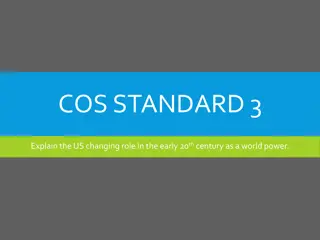Evolution of Industrial Design in the Mid-20th Century
During the mid-20th century, a shift towards functional and geometric designs in industrial objects emerged, moving away from excessive ornamentation. Prominent figures like Belle Kogan and Norman Bel Geddes revolutionized industrial design, focusing on simplification and accessibility. Events such as the New York World's Fair showcased futuristic visions and technical innovation in design, paving the way for a new era of industrial creativity.
Download Presentation

Please find below an Image/Link to download the presentation.
The content on the website is provided AS IS for your information and personal use only. It may not be sold, licensed, or shared on other websites without obtaining consent from the author. Download presentation by click this link. If you encounter any issues during the download, it is possible that the publisher has removed the file from their server.
E N D
Presentation Transcript
Mid-20thCentury ID Promoting Good Design Again History of Industrial design Lecture #11 Fall 2016 | INDS110C Adjunct: Troy Barber tbarber@ccsnh.edu
Curated by Philip Johnson (1906- 2005), Department of Architecture Aesthetically pleasing, functional objects should be available to everyone, not just an elite few. Designers began to reject excessive ornamentation, instead shifting toward more simplified and geometric shapes Some of the most significant objects developed at this time were simple machines that addressed complex problems Machine Art @ MOMA (1934)
Appreciation of beauty in the Platonic sense Objects should have Technical Beauty Visual Complexity Moderately simple mechanical functions Glorifiedmodern American industry, and encouraged viewers to participate in the revelry first by revering the corporate contributors, then by handling, buying, and judging their wares Machine Art @ MOMA (1934)-continued
Belle Kogan (1902-2000) Russian-American Industrial Designer Regarded as first prominent female industrial designer in United States Immigrated to PA in 1906 Studied mechanical drawing as a Sr. in high school Attended both Pratt and RISD Opened her first office in 1932 One of the first to experiment w/ plastics
Second only to 1904 St. Louis Louisiana Purchase Exposition in size Covered 1,200+ acres 44 million+ attended over two seasons First exposition to be based on the future 60 foreign governments exhibited Planning began in 1935 to lift NYC out of the Great Depression Split into different zones: Transportation Zone, Communications and Business Systems Zone, the Food Zone, Government Zone, etc. New York World s Fair (1939-1940)
Norman Bel Geddes (1893-1958) American Industrial Designer Bel Geddes designed the Futurama exhibit for General Motors in the Transportation Zone. Huge diorama depicting array of miniature highways, towns, 500,000 individually designed homes, 50,000 miniature vehicles, waterways, and a million miniature trees. Scenery eventually became larger as viewers moved through exhibit. FYI: Belgian Pavilion designed by Henry van de Velde (!)
Organic Design in Home Furnishings (1940) MOMA in 1930 s railed against the decade s commercial motivations that underpinned American ID Advocated standards based upon: Suitability to purpose, material, and manufacturing process(es) Very International Style, very Bauhaus 1940, sponsored a competition titled Organic Design in Home Furnishings Meaning: molded forms manufactured using industrial processes and materials such as laminated woods Flexibility, e.g. modules, configured, etc.
Hugo Alvar Henrik Aalto (1898-1976) Finnish Architect , Industrial Designer, Sculptor, Painter Studied under Josef Hoffman @ Wiener Werkstatte Most famous for his work experimenting with bent plywood chairs, see: Paimio Chair "Father of Modernism" in Scandinavia.
Jens Risom (1916-) Danish American Furniture Designer 1938, founded Hans Knoll Furniture Company (w/ Hans Knoll) 20 pieces including stools, armchairs, and lounge seating made from cedar and surplus webbing 1941 wood chair constructed using synthetic material nylon purchased from U.S. Army surplus Most notable: Lounge Chair Model 654W (1941)
Gordon Russell (1892-1980) English Designer, Craftsman During Second World War was Chairman of the British government's Utility Furniture Design Panel Austerity conditions during WWII; utilitarian design found acceptance with the aid of government support Embodied standards to insure economy in the use of government-controlled raw materials (timber, skilled labor, etc.)
Gordon Russell (1892-1980)
Ernst Race (1913-1964) English Textile & Furniture Designer Best know design is the BA3 Aluminum Chair (1945)
Hans Coray (1906-1991) Swiss Artist & Furniture Designer Best know design is the Landi Chair (1938)
Grant Information Get IT is sponsored by a $2.5 million grant from the U.S. Department of Labor, Employment & Training Administration TAACCCT Grant #TC-26498-14-60-A-33 NHTI, Concord s Community College, is an equal opportunity employer, and adaptive equipment is available upon request to persons with disabilities. This workforce solution was funded by a grant awarded by the U.S. Department of Labor s Employment and Training Administration. The solution was created by the grantee and does not necessarily reflect the official position of the U.S. Department of Labor. The Department of Labor makes no guarantees, warranties, or assurances of any kind, express or implied, with respect to such information, including any information on linked sites, and including, but not limited to accuracy of the information or its completeness, timeliness, usefulness, adequacy, continued availability or ownership.
NHTI information and Attribution NHTI, Concord s Community College 31 College Drive Concord, NH 03301 www.nhti.edu Creative Commons Attribution 4.0 International License INDS 110C History of Design curriculum by Troy Barber is licensed under the Creative Commons Attribution 4.0 International License. To view a copy of this license visit http://creativecommons.org/licenses/by/4.0/deed.en_US. http://creativecommons.org/licenses/by/4.0/deed.en_US























